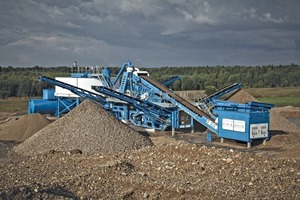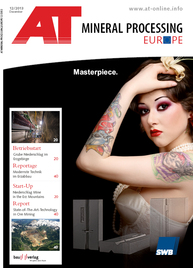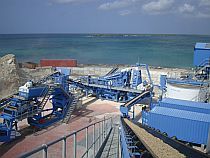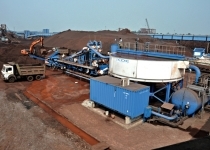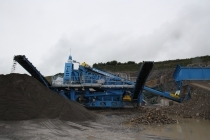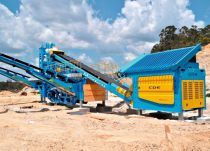Sand washing plant for reducing clay contamination
Stroytekhservis Cherepovets is a quarry company in the west of Vologda Oblast/Russia, established in 2005 and specialised in the production, sales and transportation of sand and aggregates. The company has purchased a new M2500 washing plant from CDE which is significantly reducing clay and dust contamination and producing a range of washed sand and aggregates (Fig.).
Stroytekhservis Cherepovets approached CDE’s Russian partner, Mining Technologies, in September 2012 and presented a natural sand and gravel material containing over 8 % clay content which had to be cleaned. Stroytekhservis required a 120 t/h plant that would produce 4 washed and sized products; a 0-3 mm building sand, a 3-5 mm concrete sand, a 5-25 mm aggregate and a +25 mm aggregate. The raw material is 0-40 mm sand and gravel. Stroytekhservis also required a water treatment system as they had limited space to accommodate settling ponds and additionally they wanted to reduce the requirement for fresh water to feed the plant.
After a thorough sieve analysis at the quarry, the equipment specified to process the material was a M2500 washing plant and an AquaCycle thickener. Mining Technologies invited representatives from Stroytekhservis to visit a nearby CDE installation in Priozersk in the Leningradsky region. CDE specified a M2500 to tackle the problem of clay and dust contamination. The requirements for concrete sand are defined by the Russian state standard GOST 8736-93. The plant also includes an AquaCycle thickener which was selected for its recycling benefits as it significantly reduces the volume of fresh water required as up to 90 % of the water used in the washing plant is re-circulated around the plant.
Material first enters the plant at the M14 feed hopper where a manual tipping reject grid remove the +150 mm material. The M2500’s integrated feed conveyor delivers the material to the ProGrade screen. CDE Transfer Point Technology specifies that the belt width is 1000 mm, which is the same width as the belt feeder. This ensures minimal wear, no spillage and maximum efficiency when material passes between the hopper and conveyor. Polyurethane wear pads are also fitted at this transfer point which further increases wear resistance.
From the feed conveyor, material is discharged to the Prograde P2-75 double deck rinsing screen. Prior to this a wash box fitted to the head of the feed conveyor ensures sufficient water is added to allow effective screening. The top deck removes the +25 mm material which is stockpiled using one of the 9 m wing conveyors. The bottom deck of the ProGrade is a split screen where the first part of the screen has very small apertures where the 0-3 mm material can pass through and further down the screen the apertures increase in size to allow the 3-5 mm material to pass through. The 5-25 mm product travels down the screen and goes directly to the second stockpile conveyor on the M2500.
The 3-5 mm material is transferred via jet pump to one half of the dewatering screen on the integrated EvoWash sand washing plant. The polyurethane screen guarantees maximum dewatering of the 3-5 mm sand. Replaceable polyurethane side wall protection on the EvoWash screen minimises material on steel contact, reducing wear and increasing the working life of the machine. The 3-5 mm product is stockpiled to the third M2500 conveyor with a stockpile capacity of 150 m3. The dewatering screen is split in half to ensure that 2 products can be dewatered at the same time.
Before the 0-3 mm product reaches the dewatering screen it must be pumped from the bottom deck of the ProGrade to the HydroCyclone on the EvoWash. HydroCyclone technology facilitates highly accurate separation of silts and clays from the final washed sand product. The fine sand fraction is discharged via the cyclone underflow to the rubber lined feedbox which distributes the material evenly onto the second side of the dewatering screen. This maximises the screening area and ensures high efficiency dewatering. This product is then stockpiled from the fourth M2500 E4X conveyor. Meanwhile the -63 µm fraction overflows the HydroCyclone and is transferred along with the waste water to the next stage of processing. This overflow is discharged at the highest point of the plant which negates the need for additional pumping.
Excess fines are passed to the AquaCycle A400 thickener complete with CDE Flocstation. The AquaCycle design allows for high rate settlement of these fine particles to the bottom of the thickener tank. The FlocStation acts as the delivery system for polyelectrolyte to the AquaCycle to facilitate settlement of sludge. Sludge settles at the bottom of the tank where a set of rakes ensure that the sludge is maintained at an even consistency before it is discharged to ponds. Clean water overflows the thickener and recycles to the AS404 water tank, a complete water storage and pumping system for the recycling of recovered water around the washing plant.

